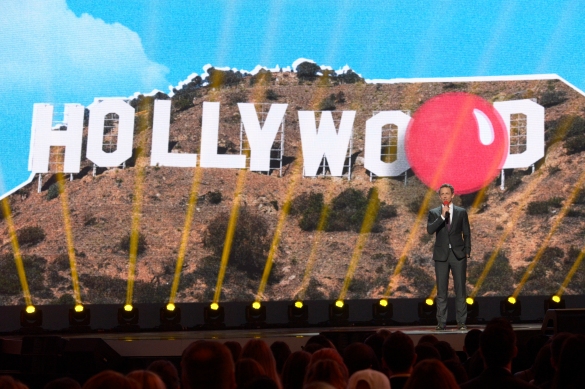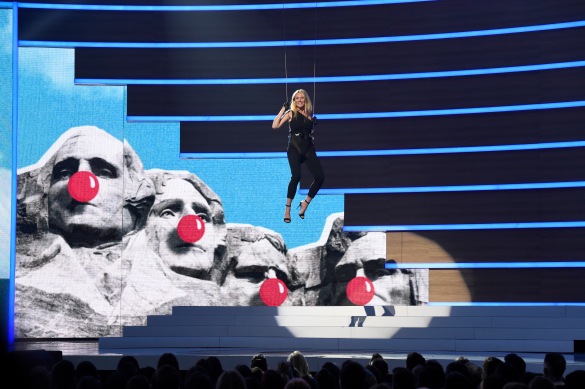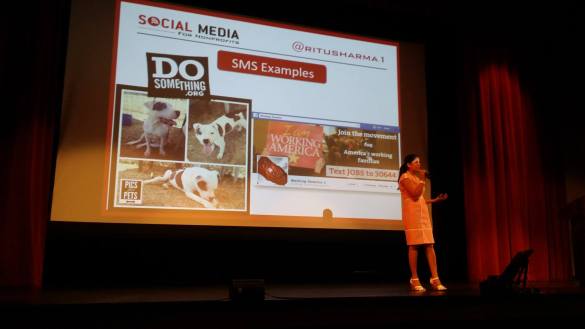This article originally appeared in The Guardian
Launching a national fundraising event in a country of 320 million people and multiple time zones may seem like an ambitious gamble. But UK charity Comic Relief hopes the first Red Nose Day USA, which culminated on 21 May with a telethon raising over $21m (£13.6m), will prove to be worth the risk.
Red Nose Day USA builds on the success of its UK namesake which, since its launch in 1988, has raised more than £1bn to help 50 million people in the poorest communities at home and abroad.
The biennial Red Nose Day UK fundraiser encourages people to “do something funny for money” in their school, community or workplace. It concludes with a live TV show and telethon on BBC1, which in March 2015 raised over £78m and attracted 8.5 million viewers.
Around 3.2 million viewers watched the inaugural Red Nose Day USA’s slick, three-hour broadcast from New York featuring live comedy sketches, musical performances and pre-recorded acts.
The US show also included pre-recorded celebrity reports from the field (Jack Black in Uganda and Michelle Rodriguez in Peru) and household name hosts (Seth Meyers, David Duchovny and Jane Krakowski) to urge viewers to donate during the show.
Twelve non-profit organisations in the US and worldwide will benefit from the first Red Nose Day USA, from Boys & Girls Clubs of America to international vaccination organisation, Gavi.
Red Nose Day USA is run by Comic Relief Inc as an independent sister organisation of Comic Relief UK – the charity set up in 1985 by screenwriter Richard Curtis in response to famine in Ethiopia.
Comic Relief innovation director, Amanda Horton-Mastin says the idea of a US Red Nose Day had been percolating for some time: “We share the same language, the US is an amazingly generous population and we have a lot of shared comedy.”
Campaign challenges
Given the scale of the US, it was essential to have an effective network partner so the team was delighted to secure NBC, which worked with its affiliates to promote the event locally. “With the BBC and two or three media partners you can reach everyone in the UK,” Horton-Mastin explained. “The fragmentation of the media [in the US] is a massive challenge.”
Another challenge was building brand awareness in a country where red noses mean Rudolph, not raising money: “Nobody knew us – we were starting from zero awareness.”
Walgreens – the pharmacy chain with 8,232 outlets across the US – was chosen as exclusive retailer of the campaign’s trademark red noses and other select products from vendor partners such as Mars, Kraft and Coca-Cola. Sales of these items, combined with fundraising by Walgreens’ employees and customers, raised over $8m while embedding the campaign at community level.
Bringing a new fundraising brand to market within just a few months meant that social media was a crucial element of the campaign. NBC created a dedicated app which enabled users to add a red nose image to a new or existing photo, then share on Facebook, Instagram or Twitter. Building on this, Red Nose Day USA partner M&M’s asked people to make someone laugh then share their story with the hashtag #MakeMLaugh, in return for a $1 M&M’s donation to Red Nose Day. The campaign hit its $250,000 target and raised $1.25m from M&M’s.
Additionally, the Bill & Melinda Gates Foundation pledged $25 for each photo posted on Twitter or Instagram by 1 June with the hashtag #RedNose25, up to a total $1m.
Content is king
Creating a rich source of newsworthy content that could go viral was another priority. “Content is king so we wanted to make the entertainment really strong,” Horton-Mastin added.
Telethon night highlights included a Game of Thrones mock musical by Coldplay that has attracted over 7m hits on YouTube, The Voice winner Sawyer Fredericks’ rendition of John Lennon’s Imagine and an acoustic duet by Ed Sheeran and Kermit the Frog of the Muppet Movie song, Rainbow Connection.
The strategy appears to have paid off. According to Nielsen’s Twitter TV ratings – which map the social conversation around a telecast three hours before and after the event – four million people across the US saw 149,000 Red Nose Day tweets, making it the third most social TV event of the week, behind only the NBA Draft Lottery and David Letterman’s final Late Show.
Other countries including Iceland, Finland, Germany and South Africa have hosted their own events based on Red Nose Day or Sport Relief, usually run under licence from Comic Relief. In Australia, a Red Nose Day has existed since 1987 as the main annual fundraiser for SIDS and Kids, a national charity supporting families affected by infant death. Horton-Mastin said Comic Relief will continue to look at opportunities to expand the brand where there is a giving culture and a TV culture.
In the meantime, Horton-Mastin hopes Red Nose Day USA will become an annual event: “We’ve been very optimistic and have huge aspirations, because our mission is about driving positive change using the power of entertainment.”



